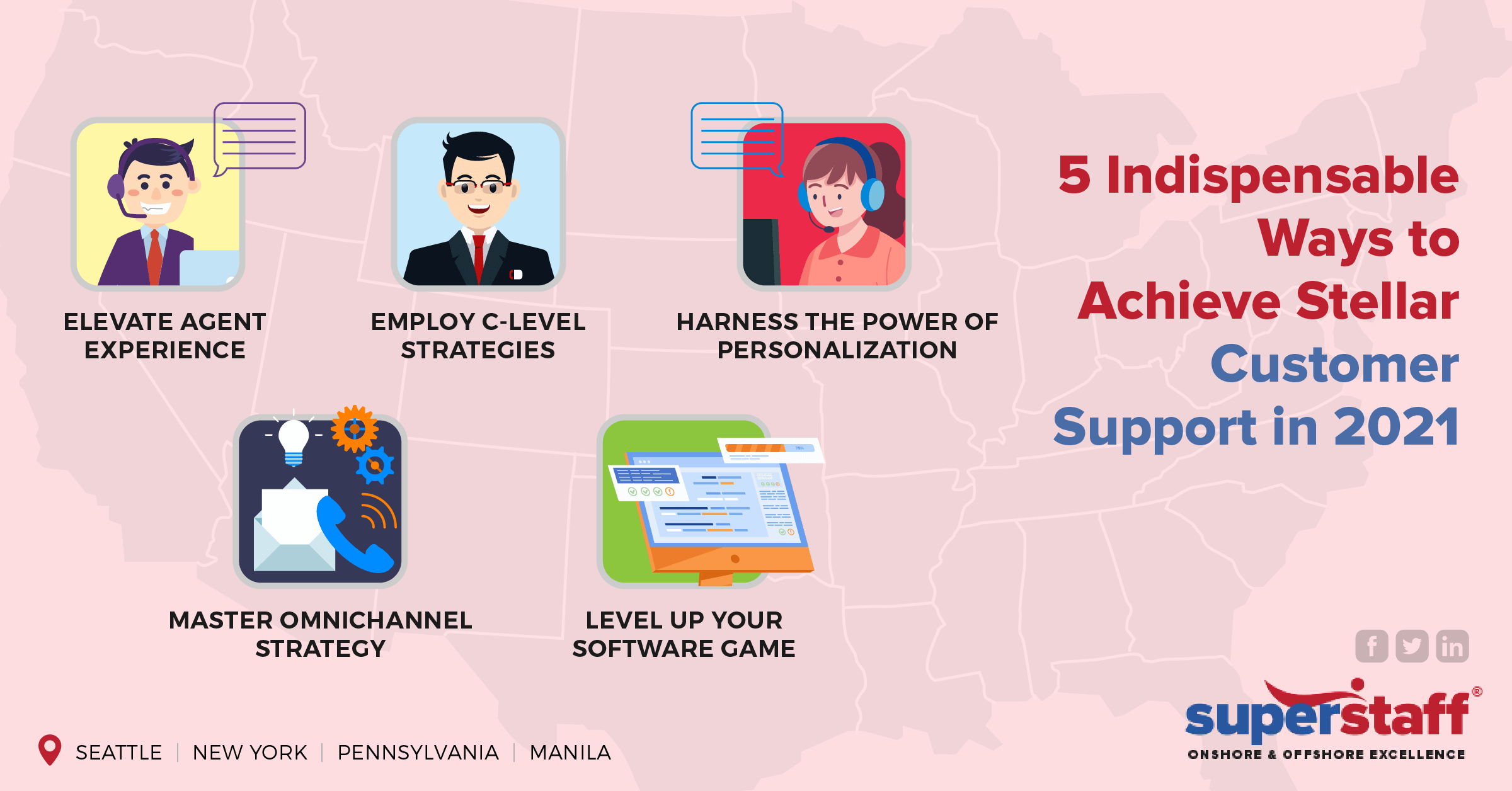
Providing excellent customer support and service has always been imperative for businesses that want to gain a competitive advantage. But as the COVID-19 pandemic paved the way for new sets of consumer behavior, the benchmark for excellence has been raised to a whole new level.
Nowadays, it is no longer enough to provide quality products or services at lower prices. Apart from the tangible benefits offered by a brand, consumers are after a holistic customer experience. According to research conducted by Treasure Data and Forbes Insights, 74% of consumers likely base their decision to buy from a company solely on their experience.
Customer experience or CX is the overall perception of your customers about your brand as a result of every interaction with your business. This includes visiting your website, reading feedback from social media, and interacting with your customer support or service team.
How Customer Support Impacts Customer Experience
In a time when competition is at the strictest, businesses’ customer support teams must make the most out of every opportunity to make a lasting impression. One CX survey done by PwC found that 1 in 3 customers will leave a brand they love after just a single bad experience, while 92% would totally abandon a company after 2 or 3 negative interactions.
In this article, we compiled ways to help businesses enhance customer experience. Use this primer as a guide to provide stellar customer support in the new normal.
Drive Superb Customer Experience With These 5 Customer Support Strategies
1. Elevate Agent Experience
The principle behind agent experience is simple: take care of your employees, and they will take care of your customers. When agents feel valued, they feel motivated to give their best at work.
In a survey conducted by Smarp, it was found that companies with high employee engagement rates are 21% more profitable. A positive agent experience also increases the company’s retention rate.
But what does it take to engage and satisfy agents in the new normal? According to Statista, the pandemic has increased work-from-home employees in the US to 44%. Even in the post-pandemic era, the permanence of remote setup for many call centers will likely be a reality. This makes engaging agents even more challenging.
Here are some suggestions to improve agent experience and satisfaction while at a work-at-home setup:
- Create a positive remote work environment.
After a year of physical distancing, it is no surprise that employees are hungry for social interaction. Utilize available tools to enhance team collaboration and encourage engagement by holding virtual game nights and other fun activities.
- Promote the wellness of your agents.
Many employees are experiencing work-from-home burnout. Show your agents that you care about their well-being by conducting virtual mental health awareness seminars and other wellness initiatives.
- Facilitate continuous improvement.
Upskill your agents through online training programs, coaching, feedback sessions, and mentoring to help them thrive in providing exemplary customer support. Additionally, leaders should give agents a sense of direction and purpose by mapping out a clear career path for them.
- Equip your agents with the best tools.
Keeping up with the latest contact center software will increase agent efficiency and minimize frustration both on the employee and the customer. Additionally, since the remote setup is reliant on internet speed, you may encourage your agents to upgrade their subscriptions by shouldering some or all of the additional expenses.
- Recognize and incentivize.
The need to be acknowledged for one’s hard work is universal. Promote healthy competition within your organization by rewarding the efforts of your top performers. The rewards can be in the form of online gift cards or Grabfood credits.
- Communicate clearly and constantly.
Business leaders must understand how unsettling the current times are for the employees. On top of health worries, many fear for their job security. Reassure your agents by maintaining a clear and open line of communication. Having an online feedback platform is also a great way to encourage communication and gain valuable employee insights.
2. Employ C-Level Strategies
The delivery of customer service and support are key functions of frontline customer service or sales personnel. However, the foundation for an effective customer service model starts at the executive level. CMO, CXO, and COO must work closely together to design the most effective customer support framework and ensure that it is communicated well to the customer support team.
Additionally, C-suites must come up with strategies that will build up customers’ perception of their brand. One powerful way to do this is to increase the presence and engagement of executives in social media.
According to Sprout Social, 70% of consumers feel more connected to the brand with executives that have a social media presence. People are interested in getting to know the people behind their favorite brands.
Understandably, many corporate leaders, especially high-profile ones, feel hesitant about being active in social media. Some are afraid to put theirs and the company’s reputation at risk by posting something embarrassing.
Here are some tips to help C-suite executives take a more active role in social media:
- Choose the right platform.
You don’t have to be active on all social media platforms. Maintaining one that suits your personality and resonates with your target audience is enough.
- Establish yourself as an industry thought leader.
Share your thoughts about the latest news affecting your industry. Promoting events and advocacies that have relevance to your business is also a great idea.
- Be consistent.
Posting regularly will make you more relevant. If you are having a hard time keeping up with your busy schedule, try maintaining a regular posting calendar.
- Show your human side.
This does not mean doing something as candid as a Tiktok video. A little peek into your lifestyles, such as your reading habits or stress-reliever activities, will do.
3. Harness the Power of Personalization
While it is true that the acceleration of digital transformation will continue to make our everyday lives more centered on technology, one should not discount the power of authentic, human connection. Modern consumers no longer want to be treated as part of a target group but as individuals with specific needs and preferences.
In an article, Forbes compiled interesting statistics that show the power of personalization. Relevant data are as follows:
- 83% of consumers are willing to share their data for a more a personalized experience (Accenture)
- 80% of consumers are more likely to patronize a brand that offers a more personalized experience (Epsilon)
- 70% of consumers say that their loyalty is influenced by a company’s understanding of their personal needs (Salesforce)
Here are some ways to make your customer support more personal:
- Empower your agents to build rapport with your customers.
Being able to relate with your customers is a must if you want to serve them better. To achieve this, train your agents to establish rapport and seek common ground with your customers. The basic rule of addressing customers by name is a great start.
- Personalize responses.
“Canned” responses may sound practical, but often they fail to answer a particular concern. Also, customers are yearning for human connection, so replying like a corporate robot will not serve your brand well. Even bots are expected to sound more human these days.
- Identify every customer touchpoint.
Customer touchpoint refers to the platform a buyer contacts your brand before, during, and after the sale. Touchpoints are vital in mapping out your customer’s journey and creating a personalized customer experience. They also give you insights into your customers’ perception of your brand.
- Allow your customer to provide feedback.
Providing a platform for customers shows that you value their feedback. It is a great tool to identify points for improvement on your end. Additionally, having a feedback platform prevents frustrated buyers from airing their dissatisfaction on social media.
- Maintain a shared data platform.
To personalize the experience for the customers, agents need visibility to customer information and interaction history. This, therefore, requires access to technology that facilitates such functions.
4. Master Omnichannel Strategy
Omnichannel strategy means providing customers with a seamless, personalized experience across all channels. All customer touchpoints should be in sync to allow the customer to flawlessly complete the journey from one channel to another.
Just like multichannel support, the omnichannel strategy provides customers with various communication platforms, such as phone, chat, email, and social media. The key difference between the two is integration.
With multichannel, customer interaction is segmented and limited within the specific channel. With omnichannel, channels are connected, and information is centralized across all platforms.
Omnichannel support eliminates the need for customers to repeat themselves, minimizing frustration on both the customer and the agent. According to a report from Gladly, 86% of customers expect agents to know them even as they jump from one platform to another.
Here are some best practices for implementing omnichannel customer support:
- Map out your customer journey.
Identifying your customers’ touchpoints will allow you to enrich your data with insights that you can use to personalize your service and support offerings.
- Build a centralized database.
To facilitate omnichannel support, agents need to see relevant customer information and communication history. This allows smooth continuity of conversation and eliminates the need for the customer to repeat his or her concerns, even as they speak to different agents.
- Integrate all systems, software, and channels.
Having synchronized technologies is the foundation of an effective omnichannel support operation. From analytics to CRM, all systems must be linked together to function as one to facilitate a smooth transition from one platform to another.
- Use automation tools and chatbots.
Enabling self-service options allows you to respond to your customers’ needs quickly even if live agents are not available at the time of contact. Automation also helps increase efficiency, as it allows your agents to focus on more complex issues.
5. Level Up Your Software Game
Thriving in today’s digitally transformed marketplace requires businesses to invest in the best cloud, AI, cybersecurity, and data analytics technology, among others. Having access to an advanced and intuitive customer support system and software is not just an advantage; it is a requirement for success.
But with so many options available, how do you know which is the ideal solution for your business? The answer depends on your business and goals. Chances are, you are going to need more than one software.
Use this checklist as a guide in choosing the right customer support software:
- Does it have advanced integration and automation capabilities?
- Does it complement the strengths of your customer support team and model?
- Does it support real-time time communication (internally and externally) via phone, chat, or video?
- Does it facilitate omnichannel and multichannel support?
- Does it allow your team members to collaborate?
- Does it provide access to crucial data and reports, such as chat transcripts, call logs, and analytics?
- Does it offer advanced information security, including the protection of shared data?
- Does it allow seamless remote work setup?
An Innovative and Client-Centric Customer Support Outsourcing Partner
The business landscape is no longer the same as it used to be a year ago, and it will likely continue evolving. Companies must adapt to the fast-changing demands of the consumers. To increase success in this area, it is best to partner with a forward-looking customer support outsourcing company.
If you are looking for a BPO partner that is up to date with the latest in the customer support industry, SuperStaff BPO has you covered. We continue to capitalize on the strengths of both intelligent technology and the human workforce to deliver seamless, excellent customer support outsourcing in the Philippines.
Contact us to learn more about how we can help you thrive in a customer experience-centered business world.






